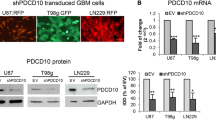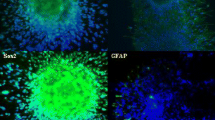Abstract
Background
The efficacy of current immunotherapeutic strategies for patients with glioblastoma multiforme (GBM) remains unsatisfactory. The purpose of this study was to investigate the correlation between tumor necrosis factor alpha-induced protein 2 (TNFAIP2) and immunogenic cell death (ICD) in GBM, and to examine the effect of TNFAIP2 knockdown and anti-PD-1 combination treatment in a mouse glioma model.
Methods
The CGGA and TCGA databases were used to explore the possible function of TNFAIP2 in GBM. Multiplex immunohistochemistry (mIHC) staining was performed to detect the immune infiltration of tissues. Western blot, quantitative real-time polymerase chain reaction (qRT-PCR), flow cytometry, and enzyme linked immunosorbent assay (ELISA) were utilized to detect the release of damage-associated molecular patterns (DAMPs) and the activation of the immune response. A mouse glioma model was applied to examine the induction of immune response.
Results
In vitro and in vivo studies demonstrated that TNFAIP2 knockdown increased the surface exposure of calreticulin (CALR), heat shock protein 70 kDa (HSP70), and heat shock protein 90 kDa (HSP90) in GBM cell lines, thereby inducing immunogenic cell death (ICD). Importantly, the study found that TNFAIP2 knockdown in combination with anti-PD-1 therapy significantly improved the overall survival of glioma in a mouse model.
Conclusions
TNFAIP2 knockdown induces ICD by downregulating TNFAIP2 in GBM. In addition, TNFAIP2 knockdown sensitized glioma to anti-PD-1 therapy. Hence, targeting TNFAIP2 alone or in combination with anti-PD-1 therapy may be a potential strategy for GBM treatment through ICD.





Similar content being viewed by others
Data availability
The datasets used during the current study are available from the corresponding author on reasonable request.
References
Weber JS, D’Angelo SP, Minor D, Hodi FS, Gutzmer R, Neyns B et al (2015) Nivolumab versus chemotherapy in patients with advanced melanoma who progressed after anti-CTLA-4 treatment (CheckMate 037): a randomised, controlled, open-label, phase 3 trial. Lancet Oncol 16(4):375–84. https://doi.org/10.1016/S1470-2045(15)70076-8
Motzer RJ, Escudier B, McDermott DF, George S, Hammers HJ, Srinivas S et al (2015) Nivolumab versus everolimus in advanced renal-cell carcinoma. N Engl J Med. 373(19):1803–13. https://doi.org/10.1056/NEJMoa1510665
Sharma P, Retz M, Siefker-Radtke A, Baron A, Necchi A, Bedke J et al (2017) Nivolumab in metastatic urothelial carcinoma after platinum therapy (CheckMate 275): a multicentre, single-arm, phase 2 trial. Lancet Oncol 18(3):312–22. https://doi.org/10.1016/S1470-2045(17)30065-7
Medikonda R, Dunn G, Rahman M, Fecci P, Lim M (2021) A review of glioblastoma immunotherapy. J Neurooncol 151(1):41–53. https://doi.org/10.1007/s11060-020-03448-1
Xu S, Tang L, Li X, Fan F, Liu Z (2020) Immunotherapy for glioma: current management and future application. Cancer Lett 476:1–12. https://doi.org/10.1016/j.canlet.2020.02.002
Sarma V, Wolf FW, Marks RM, Shows TB, Dixit VM (1992) Cloning of a novel tumor necrosis factor-alpha-inducible primary response gene that is differentially expressed in development and capillary tube-like formation in vitro. J Immunol 148(10):3302–3312
Jia L, Shi Y, Wen Y, Li W, Feng J, Chen C (2018) The roles of TNFAIP2 in cancers and infectious diseases. J Cell Mol Med 22(11):5188–95. https://doi.org/10.1111/jcmm.13822
Hase K, Kimura S, Takatsu H, Ohmae M, Kawano S, Kitamura H et al (2009) M-Sec promotes membrane nanotube formation by interacting with Ral and the exocyst complex. Nat Cell Biol 11(12):1427–32. https://doi.org/10.1038/ncb1990
Li J, Song Y, Yu B, Yu Y (2020) TNFAIP2 promotes non-small cell lung cancer cells and targeted by miR-145–5p. DNA Cell Biol 39(7):1256–63. https://doi.org/10.1089/dna.2020.5415
Lin MS, Zhong HY, Yim RL, Chen QY, Du HL, He HQ et al (2022) Pan-cancer analysis of oncogenic TNFAIP2 identifying its prognostic value and immunological function in acute myeloid leukemia. BMC Cancer 22(1):1068. https://doi.org/10.1186/s12885-022-10155-9
Xu T, Yang Y, Chen Z, Wang J, Wang X, Zheng Y et al (2023) TNFAIP2 confers cisplatin resistance in head and neck squamous cell carcinoma via KEAP1/NRF2 signaling. J Exp Clin Cancer Res 42(1):190. https://doi.org/10.1186/s13046-023-02775-1
Chen LC, Chen CC, Liang Y, Tsang NM, Chang YS, Hsueh C (2011) A novel role for TNFAIP2: its correlation with invasion and metastasis in nasopharyngeal carcinoma. Mod Pathol 24(2):175–84. https://doi.org/10.1038/modpathol.2010.193
Galluzzi L, Vitale I, Warren S, Adjemian S, Agostinis P, Martinez AB et al (2020) Consensus guidelines for the definition, detection and interpretation of immunogenic cell death. J Immunother Cancer. https://doi.org/10.1136/jitc-2019-000337
Kroemer G, Galassi C, Zitvogel L, Galluzzi L (2022) Immunogenic cell stress and death. Nat Immunol 23(4):487–500. https://doi.org/10.1038/s41590-022-01132-2
Obeid M, Tesniere A, Ghiringhelli F, Fimia GM, Apetoh L, Perfettini JL et al (2007) Calreticulin exposure dictates the immunogenicity of cancer cell death. Nat Med 13(1):54–61. https://doi.org/10.1038/nm1523
Fucikova J, Becht E, Iribarren K, Goc J, Remark R, Damotte D et al (2016) Calreticulin expression in human non-small cell lung cancers correlates with increased accumulation of antitumor immune cells and favorable prognosis. Cancer Res 76(7):1746–56. https://doi.org/10.1158/0008-5472.CAN-15-1142
Garg AD, Vandenberk L, Fang S, Fasche T, Van Eygen S, Maes J et al (2017) Pathogen response-like recruitment and activation of neutrophils by sterile immunogenic dying cells drives neutrophil-mediated residual cell killing. Cell Death Differ 24(5):832–43. https://doi.org/10.1038/cdd.2017.15
Sistigu A, Yamazaki T, Vacchelli E, Chaba K, Enot DP, Adam J et al (2014) Cancer cell-autonomous contribution of type I interferon signaling to the efficacy of chemotherapy. Nat Med 20(11):1301–9. https://doi.org/10.1038/nm.3708
Li Y, Zhang H, Li Q, Zou P, Huang X, Wu C et al (2020) CDK12/13 inhibition induces immunogenic cell death and enhances anti-PD-1 anticancer activity in breast cancer. Cancer Lett 495:12–21. https://doi.org/10.1016/j.canlet.2020.09.011
Limagne E, Thibaudin M, Nuttin L, Spill A, Derangere V, Fumet JD et al (2019) Trifluridine/tipiracil plus oxaliplatin improves PD-1 blockade in colorectal cancer by inducing immunogenic cell death and depleting macrophages. Cancer Immunol Res 7(12):1958–69. https://doi.org/10.1158/2326-6066.CIR-19-0228
Pfirschke C, Engblom C, Rickelt S, Cortez-Retamozo V, Garris C, Pucci F et al (2016) Immunogenic chemotherapy sensitizes tumors to checkpoint blockade therapy. Immunity 44(2):343–54. https://doi.org/10.1016/j.immuni.2015.11.024
Srivastava S, Furlan SN, Jaeger-Ruckstuhl CA, Sarvothama M, Berger C, Smythe KS et al (2021) Immunogenic chemotherapy enhances recruitment of CAR-T cells to lung tumors and improves antitumor efficacy when combined with checkpoint blockade. Cancer Cell 39(2):193–208. https://doi.org/10.1016/j.ccell.2020.11.005
Voloshin T, Kaynan N, Davidi S, Porat Y, Shteingauz A, Schneiderman RS et al (2020) Tumor-treating fields (TTFields) induce immunogenic cell death resulting in enhanced antitumor efficacy when combined with anti-PD-1 therapy. Cancer Immunol Immunother 69(7):1191–204. https://doi.org/10.1007/s00262-020-02534-7
Roney K (2019) Bone marrow-derived dendritic cells. Methods Mol Biol 1960:57–62. https://doi.org/10.1007/978-1-4939-9167-9_4
Kimura S, Yamashita M, Yamakami-Kimura M, Sato Y, Yamagata A, Kobashigawa Y et al (2016) Distinct roles for the N- and C-terminal regions of M-Sec in Plasma membrane deformation during tunneling nanotube formation. Sci Rep 6:33548. https://doi.org/10.1038/srep33548
Barzilai S, Blecher-Gonen R, Barnett-Itzhaki Z, Zauberman A, Lebel-Haziv Y, Amit I et al (2016) M-sec regulates polarized secretion of inflammatory endothelial chemokines and facilitates CCL2-mediated lymphocyte transendothelial migration. J Leukoc Biol 99(6):1045–55. https://doi.org/10.1189/jlb.3VMA0915-427R
Xie Y, Wang B (2017) Downregulation of TNFAIP2 suppresses proliferation and metastasis in esophageal squamous cell carcinoma through activation of the Wnt/beta-catenin signaling pathway. Oncol Rep 37(5):2920–8. https://doi.org/10.3892/or.2017.5557
Zhao D, Deng SC, Ma Y, Hao YH, Jia ZH (2018) miR-221 alleviates the inflammatory response and cell apoptosis of neuronal cell through targeting TNFAIP2 in spinal cord ischemia-reperfusion. Neuroreport 29(8):655–60. https://doi.org/10.1097/WNR.0000000000001013
Guo F, Xu Q, Lv Z, Ding HX, Sun LP, Zheng ZD et al (2020) Correlation between TNFAIP2 gene polymorphism and prediction/prognosis for gastric cancer and its effect on TNFAIP2 protein expression. Front Oncol 10:1127. https://doi.org/10.3389/fonc.2020.01127
Ainiwaer Z, Maisaidi R, Liu J, Han L, Husaiyin S, Lu J et al (2020) Genetic polymorphisms of PGF and TNFAIP2 genes related to cervical cancer risk among Uygur females from China. BMC Med Genet 21(1):212. https://doi.org/10.1186/s12881-020-01144-5
Fucikova J, Kralikova P, Fialova A, Brtnicky T, Rob L, Bartunkova J et al (2011) Human tumor cells killed by anthracyclines induce a tumor-specific immune response. Cancer Res 71(14):4821–33. https://doi.org/10.1158/0008-5472.CAN-11-0950
Bezu L, Sauvat A, Humeau J, Gomes-da-Silva LC, Iribarren K, Forveille S et al (2018) eIF2alpha phosphorylation is pathognomonic for immunogenic cell death. Cell Death Differ 25(8):1375–93. https://doi.org/10.1038/s41418-017-0044-9
Herbst RS, Soria JC, Kowanetz M, Fine GD, Hamid O, Gordon MS et al (2014) Predictive correlates of response to the anti-PD-L1 antibody MPDL3280A in cancer patients. Nature 515(7528):563–7. https://doi.org/10.1038/nature14011
Lim M, Weller M, Idbaih A, Steinbach J, Finocchiaro G, Raval RR et al (2022) Phase III trial of chemoradiotherapy with temozolomide plus nivolumab or placebo for newly diagnosed glioblastoma with methylated MGMT promoter. Neuro Oncol 24(11):1935–49. https://doi.org/10.1093/neuonc/noac116
Omuro A, Brandes AA, Carpentier AF, Idbaih A, Reardon DA, Cloughesy T et al (2023) Radiotherapy combined with nivolumab or temozolomide for newly diagnosed glioblastoma with unmethylated MGMT promoter: an international randomized phase III trial. Neuro Oncol 25(1):123–34. https://doi.org/10.1093/neuonc/noac099
Cloughesy TF, Mochizuki AY, Orpilla JR, Hugo W, Lee AH, Davidson TB et al (2019) Neoadjuvant anti-PD-1 immunotherapy promotes a survival benefit with intratumoral and systemic immune responses in recurrent glioblastoma. Nat Med 25(3):477–86. https://doi.org/10.1038/s41591-018-0337-7
Acknowledgements
We would like to thank Ms. Vikky and Mr. Xie Tao for language polishing.
Funding
This work was supported by the China Postdoctoral Science Foundation (2022M721500); the National Natural Science Foundation of China (No. 82072762); the National Natural Science Foundation of China (No. 82103668); the Medical Scientific Research Foundation of Dongguan People's Hospital under Grant (K202021).
Author information
Authors and Affiliations
Contributions
CH, JY, and YK considered and designed this study; CH, SS, MG, JJ, CM, YZ and JZ performed the experiments; All authors performed data analysis; CH, SS, MG, JJ, CM, and JZ wrote the draft; TW, TC, YL, JY, and YK revised the manuscript; CH, SS, and MG contributed equally to this work; YK is responsible for the overall content as guarantor.
Corresponding authors
Ethics declarations
Conflict of interest
The authors have no conflict of interest.
Ethical approval
Approval of the research protocol by an Institutional Reviewer Board: Informed consent was obtained in all cases, and study protocols were approved by the Ethical Committee of Zhujiang Hospital. The animal protocols used in the present study were approved by the Animal Care and Use Committee of Southern Medical University (LAEC-2022–151) and complied with the Code of Ethics for Animal Experimentation.
Additional information
Publisher's Note
Springer Nature remains neutral with regard to jurisdictional claims in published maps and institutional affiliations.
Supplementary Information
Below is the link to the electronic supplementary material.
Rights and permissions
Springer Nature or its licensor (e.g. a society or other partner) holds exclusive rights to this article under a publishing agreement with the author(s) or other rightsholder(s); author self-archiving of the accepted manuscript version of this article is solely governed by the terms of such publishing agreement and applicable law.
About this article
Cite this article
Hou, C., Shi, S., Gao, M. et al. Targeting TNFAIP2 induces immunogenic cell death and sensitizes glioblastoma multiforme to anti-PD-1 therapy. J Neurooncol 165, 79–90 (2023). https://doi.org/10.1007/s11060-023-04449-6
Received:
Accepted:
Published:
Issue Date:
DOI: https://doi.org/10.1007/s11060-023-04449-6




